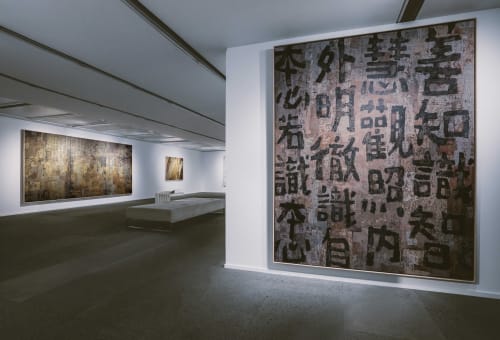Galerie du Monde is pleased to present a solo exhibition of Fong Chung-Ray, the influential contemporary artist, who as a member of The Fifth Moon Group, a group of contemporary Chinese artists, were at the forefront of the modern art movement in Taiwan in the 1960s. Titled Enlightenment: 1998-2018, this exhibition showcases 15 works from the last two decades, with some pieces that have never been seen in the public before. This solo exhibition comes after five collaborations between the artist and Galerie du Monde, including the retrospective of Fong Chung-Ray’s work in 2015, three Fifth Moon Group exhibitions at the gallery in 2016 and 2017, and at Art Basel Hong Kong in 2017.
In the past six decades, Fong Chung-Ray has trailblazed an experimental fusion of Chinese traditional ink art and abstract expressionism, a result of a unique amalgamation of cultural, stylistic, and period influences in his life. Born in China’s Henan province in 1934 into a family of accomplished scholars and artists, Fong was exposed to the learning and appreciation of fine arts since childhood. However, the civil wars and foreign invasions ensued, which led to him joining the military and later moving to Taiwan as a teenager. Thereafter, Fong became inspired by abstract expressionism, which he firmly believes is the closest movement spiritually to traditional Chinese paintings, and has invariably remained significant throughout his artistic career, comprising of a wide range of styles and medium.
In 1989, Fong Chung-Ray developed a technique in which he applied acrylic onto plastic sheets with the resulting designs transferred onto paper. Evidently, works made during this period are marked by a transition from his previous fluid, natural landscapes to harsher, man-made scenery, reflecting his shifting views on the evolution of mankind, ultimately representing the passage of time. Artworks made at that time were deeply rooted in a realm that is void of any fixated notion on time or place. Concurrently, Fong Chung-Ray was also inspired by the minute details produced by the process of the “decay”, which prompted him to coarsen the surface of his works in order to examine the materiality. The multilayered concoction of materials immediately conjures visions of flaking paint, scratches, and torn paper, all layered over writing, revealing details that goes beyond external presentation.
Also presented in this exhibition are Fong Chung-Ray’s latest collages incorporating Buddhist texts, where he continues his characteristically unconfined approach of infusing calligraphy into some of his artworks. Fong uses Buddhist scriptures, Indian Sanskrit and esoteric poetries as he realizes that the art making process is parallel to the teachings of Buddhism, emphasizing the importance of meditation and experiential wisdom for attainting realization. His works make the experience of viewing his artworks more visceral, transposing viewers into a metaphysical world that is both mystical and powerful. The crude and spontaneous qualities of his characters owe a great deal to the raw brush strokes of early expressionists that Fong Chung-Ray admired.
“2017-7-25” featured in this exhibition, is one of Fong’s masterpieces exemplifying his recent art practice, which displays the multitude of characteristics of his experimental yet determined pursuit of his unique identity. The combination of a seemingly simple composition in these series of works, with geometric shapes overlaid with unrestrained Buddhist text, alludes to the ephemerality of not only his artworks, but also his self-enlightenment. He has remarked, “I once thought about the meaning of eternity. It simply seemed impossible for eternity to exist. The universe itself has a life cycle, and time tends to destroy all things eventually.”
The new works in Enlightenment: 1998-2018 offer a glimpse into Fong’s consistent and highly conceptualized techniques, highlighting the ephemeral character of his oeuvre and his identity. With references to abstract expressionism, ink art, Buddhism and materiality, coupled with original technique, Fong renders his works as idiosyncratic in such a way that allows for a deeper contemplation.

